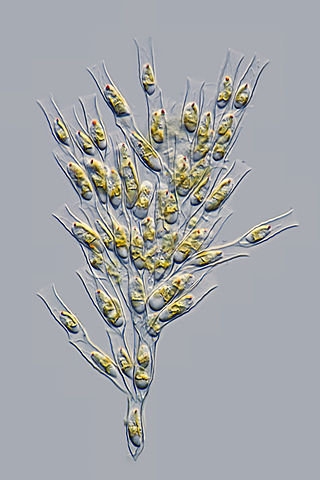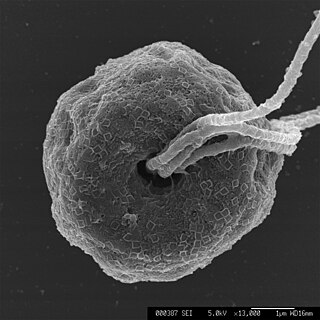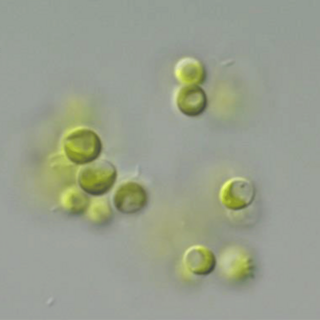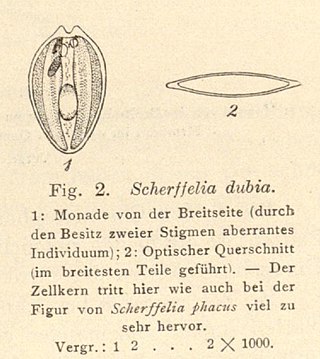
Chlamydomonadales, also known as Volvocales, are an order of flagellated or pseudociliated green algae, specifically of the Chlorophyceae. Chlamydomonadales can form planar or spherical colonies. These vary from Gonium up to Volvox. Each cell has two flagella, and is similar in appearance to Chlamydomonas, with the flagella throughout the colony moving in coordination.

Pedinellales is a group of single-celled algae found in both marine environments and freshwater.

The glaucophytes, also known as glaucocystophytes or glaucocystids, are a small group of unicellular algae found in freshwater and moist terrestrial environments, less common today than they were during the Proterozoic. The stated number of species in the group varies from about 14 to 26. Together with the red algae (Rhodophyta) and the green algae plus land plants, they form the Archaeplastida.

The Chrysophyceae, usually called chrysophytes, chrysomonads, golden-brown algae or golden algae, are a large group of algae, found mostly in freshwater. Golden algae is also commonly used to refer to a single species, Prymnesium parvum, which causes fish kills.
Cryptomonas is the name-giving genus of the Cryptomonads established by German biologist Christian Gottfried Ehrenberg in 1831. The algae are common in freshwater habitats and brackish water worldwide and often form blooms in greater depths of lakes. The cells are usually brownish or greenish in color and are characteristic of having a slit-like furrow at the anterior. They are not known to produce any toxins. They are used to feed small zooplankton, which is the food source for small fish in fish farms. Many species of Cryptomonas can only be identified by DNA sequencing. Cryptomonas can be found in several marine ecosystems in Australia and South Korea.

Eustigmatophytes are a small group of eukaryotic forms of algae that includes marine, freshwater and soil-living species.

Pyramimonadales are an order of green algae in the Chlorophyta. The chloroplasts of phototrophic euglenids probably came from endosymbiosis with a member of this order.

Chlamydomonadaceae is a family of algae within the order Chlamydomonadales. Traditionally, it has been defined as containing single-celled flagellates with a cell wall.

Selenastraceae is a family of green algae in the order Sphaeropleales. Members of this family are common components of the phytoplankton in freshwater habitats worldwide. A few species have been found in brackish and marine habitats, such as in the Baltic Sea.
Dictyochloris is a genus of green algae in the class Chlorophyceae. It is the sole genus of the family Dictyochloridaceae. It is commonly found in terrestrial and subaerial habitats.

Dictyosphaerium is a genus of green algae, in the family Chlorellaceae. It occurs in freshwater habitats around the world and is planktonic.

Mychonastes is a genus of green algae, specifically of the Chlorophyceae. It is the sole genus of the family Mychonastaceae.

Paulschulzia is a genus of green algae, specifically of the family Tetrasporaceae.
Podohedriella is a genus of green algae in the family Selenastraceae. It is found in freshwater habitats or on damp wood.

Scherffelia is a genus of green algae in the family Chlorodendraceae.

Selenastrum is a genus of green algae in the family Selenastraceae. It is common in freshwater habitats around the world. Most species prefer temperate or warm-temperate waters.

Stauridium is a genus of green algae in the family Hydrodictyaceae. It is very common in freshwater regions throughout the world.

Cosmarium is a genus of freshwater organisms belonging to the Charophyta, a division of green algae from which the land plants (Embryophyta) emerged.

Characiaceae is a family of green algae in the order Sphaeropleales. It contains epiphytic or planktonic algae that are unicellular or colonial. The cells are heteropolar, with basal and apical ends having different shapes. The daughter cells are often retained in the cell wall of the old mother cell, whose cell wall becomes gelatinized.

Aphanothece is a polyphyletic genus with 63 accepted species. The name is derived from the Greek words, ‘aphanes’ and ‘theke’ which mean “invisible" and “box or sheath” respectively. This genera is cosmopolitan, found in soils, thermal springs and other benthic, freshwater, marine, hypersaline, and moist terrestrial environments. Morphology can vary, with both microscopic and macroscopic colonies large enough to be collected and preserved in herbarium records.

















